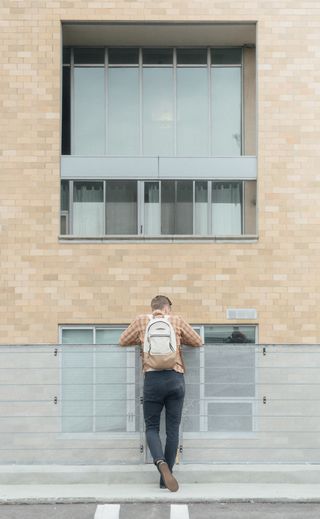Suicide
Misdirection
The transition to college: a brave and startling truth.
Posted October 25, 2017

No doubt the transition to college can be difficult to navigate, both for incoming first-year students and their parents.
Let’s start with the latter.
As my friend Ginny commented on Facebook about her son’s impending departure, “I will not post a picture of my son sleeping in his bed for the last time (ok, I know he'll be back but not the same) and I will not stand by his bed and watch him sleeping and cry (I did) and I will not be irritated by my husband who pointed out he basically lived at home on and off until we got married (that doesn't help now and that better not happen!) and I will gladly make my son's favorite meal and go clothes shopping (I have no time) today because when he did he came home with four t-shirts (he is going to school in the snow belt) and I will hide my hurt when he acts weird and distant when we are on campus tomorrow. I will love him with all my heart no matter what. Just like I always have and always will. A wise friend pointed out how lucky he is and how much fun he will have and I know that is true too. Onward!”
Onward indeed. But to where…and what?
Certainly, many young people thrive in their academic environments, relishing new relationships, new challenges, and new independence. That is the best we can hope (and prepare them) for.
Yet, others find the shift from high school to college a mixed blessing or even a downright disaster.
For example, a survey of first-year college students conducted by The Jed Foundation, Partnership for Drug-Free Kids and The Jordan Porco Foundation revealed that the majority of these young people feel unprepared emotionally, “defined by the organizations as the ability to take care of oneself, adapt to new environments, control negative emotions or behavior and build positive relationships” for the trials and tribulations college can bring (Set to Go, 2015a).
They report the following.
- 45 percent felt that “it seems like everyone has college figured out but me”
- 60 percent of students wish they had gotten more help with the emotional preparation for college.
- 51 percent found it difficult at times to get emotional support at college when they needed it.
And now we know why.
Data released by JED and Kognito earlier this month revealed, “A survey of 14,584 faculty and staff members and 51,294 undergraduate students in 100+ U.S. colleges and universities found that more than half don’t feel adequately prepared to recognize, approach or recommend support services to students experiencing psychological distress, including depression, anxiety, and thoughts of suicide” (JED, 2017).
JED’s chief medical officer Dr. Victor Schwartz says, “We know that young people are likely to turn to friends and trusted adults such as parents and faculty when they are in distress...Thus, it is very important that faculty, staff, and fellow students feel comfortable having a conversation about mental health and where young people can turn to seek help.”
- 52 percent or more did not recognize ANY student exhibiting signs of psychological distress in the months prior to the survey, and
- 60 percent or more did not approach or refer ANY student exhibiting signs of psychological distress to mental health support services.
A joint statement by JED and Kognito said, “These findings are concerning considering that national data shows that nearly 1 out of every 3 college students has experienced some form of mental illness and that many college students who either contemplate or attempt suicide tell someone or show clear warning signs” (JED, 2017).
More bad news can be found in a 2014 report by the National Survey of College Counseling Centers sharing that 94 percent of counseling directors say they’ve seen an increase of students with severe psychological disturbances (Gallagher, 2014). And many colleges and universities self-report difficulty in matching supply with demand (Simon, 2017).
Sadly, they are not alone. It has long been noted that there is a deficit of mental health professionals serving adolescents and young adults.
The result? Many are self-medicating.
Caleb, then a sophomore at Tulane, told me, “It’s sad that mental health is taboo at many universities. With admissions incredibly competitive and cutthroat, I’m not surprised students enter [college] having fought anxiety and/or depression. When people begin to burn out, things can go astray, especially around alcohol, marijuana, and sex.”
Those outcomes were the subject of a study of first-year college students conducted by the Center for Adolescent Research and Education (CARE) in connection with SADD, a CARE collaborator. “According to the survey, approximately one-third of young people are experimenting with risky behaviors, many for the first time, during their first semester at college. Roughly one-third of the students surveyed reported drinking alcohol (37 percent), engaging in intimate sexual behavior (37 percent), or having sexual intercourse (32 percent) in that time period. Among these students, one-quarter to nearly half report engaging in these behaviors for the first time” (Wallace, 2015).
Perhaps even more concerning are the high diagnostic rates of mood disorders (such as anxiety and depression) and suicide (second-leading cause of death) among this cohort.
Recent articles in TIME magazine (“Teen Depression and Anxiety: Why the Kids Are Not Alright”) and The New York Times (“Why Are More American Teenagers Than Ever Suffering From Severe Anxiety?”) add perspective, poignancy, and, most important, primacy to the discussion.
That’s all good.
What isn’t good is how far many young people will go in order to appear well-adjusted, in step, popular and, well, fine. It’s a misdirection to fool peers, parents, and others with genuine interest in their well-being.
A July 2015 article in The New York Times, “Suicide on Campus and the Pressure of Perfection,” tracked Kathryn DeWitt's transition to college. It stated that she “conquered high school like a gold-medal decathlete. She ran track, represented her school at a statewide girls’ leadership program, and took eight Advanced Placement tests, including one for which she independently prepared, forgoing the class. Expectations were high. Every day at 5 p.m. test scores and updated grades were posted online. Her mother would be the first to comment should her grade go down. "I would get home from track and she would say, 'I see your grade dropped.' I would say, 'Mom, I think it’s a mistake.' And she would say, 'That’s what I thought.'" (The reason turned out to be typing errors. Ms. DeWitt graduated with straight A’s.) (Scelfo, 2015).
College turned out to be, for Kathryn, a whole different deal.
“In her first two weeks on the University of Pennsylvania campus, she hustled. She joined a co-ed fraternity, signed up to tutor elementary school students and joined the same Christian group her parents had joined at their alma mater, Stanford.
“But having gained admittance off the waitlist and surrounded by people with seemingly greater drive and ability, she had her first taste of self-doubt. ‘One friend was a world-class figure skater. Another was a winner of the Intel science competition. Everyone around me was so spectacular and so amazing and I wanted to be just as amazing as they are.’
“Classmates seemed to have it all together. Every morning, the administration sent out an email blast highlighting faculty and student accomplishments. Some women attended class wearing full makeup. Ms. DeWitt had acne. They talked about their fantastic internships. She was still focused on the week’s homework. Friends’ lives, as told through selfies, showed them having more fun, making more friends and going to better parties. Even the meals they posted to Instagram looked more delicious.”
When a classmate, Madison Holleran, jumped to her death from the roof of a parking garage, Kathryn posted, “What the hell, girl?! I was supposed to be the one who went first! You had so much to live for!” (Scelfo, 2015).
It was at that moment that the term “Penn Face” garnered attention nationwide, reflecting the pressure students feel to “be normal” and to fit in. Holleran was one of six Penn students who died by suicide in a 13-month stretch. Other suicides at Tulane, Cornell, and New York University also gained notice, as did eerily similar iterations of Penn Face.
The staggering suicide rate among young people belies the myth of popularity and achievement. The phrase “lonely but never alone” captures the fate of more than a few college students struggling with transition. And while many focus on the damage wrought by “helicopter parents” encroaching on their child’s newfound independence (“Lesson for parents of college students: They’re adults now, stop hovering”) (Fontaine, 2012), parents and other caring adults in the lives of young people are well advised to remain dialed-in to the true nature of the first-year college experience by engaging in open, honest dialogue and encouraging each young person to have a Plan B: someone to turn to in the new environment, be it a professor, coach, counselor, or faith-based mentor, when experiencing distress.
A 2016 to 2017 academic year qualitative research project at CARE, tracked (biweekly) the experiences of high school seniors and first-year college students, asking eight key questions.
- How are you feeling?
- What have you been doing?
- Who helped you with something?
- Whom did you help with something?
- What is the most difficult decision you had to make?
- What was the most challenging thing you faced?
- To whom do you feel connected?
- Have you experienced any loneliness, anxiety or depression?
Also included was a wellness scale on which participants would rate themselves on key lifestyle metrics of sleep, exercise, diet, stress, emotions, and relationships.
That may provide an analog for parents seeking to keep unobtrusive tabs on students far away (literally or figuratively).
As Maya Angelou (1995) wrote:
“We, this people, on a small and lonely planet
Traveling through casual space
Past aloof stars, across the way of indifferent suns
To a destination where all signs tell us
It is possible and imperative that we learn
A brave and startling truth …”
In other words, it’s better to know than not.
References
Angelou, M. (1995). A brave and startling truth. 1995. https://www.best-poems.net/poem/a-brave-and-startling-truth-by-maya-ang… (24 Oct. 2017).
Denizet-Lewis, B. (2017). Why are more American teenagers than ever suffering from severe anxiety? The New York Times. October 11, 2017. https://www.nytimes.com/2017/10/11/magazine/why-are-more-american-teena… (24 Oct. 2017).
Fontaine, J. (2012). Lesson for parents of college students: they’re adults now, stop hovering. The Palm Beach Post. September 24, 2012. http://www.palmbeachpost.com/news/local-education/lesson-for-parents-co… (24 Oct. 2017).
Gallagher, R. (2014). National survey of college counseling centers. University of Pittsburgh and American College Counseling Association. 2014. http://d-scholarship.pitt.edu/28178/1/survey_2014.pdf (24 Oct. 2017).
JED. (2017). JED and Kognito report reveals college faculty and students do not feel prepared to notice and help students in psychological distress. The Jed Foundation. October 4, 2017. https://www.jedfoundation.org/jed-kognito-college-report-psychological-… (24 Oct. 2017).
Scelfo, J. (2015). Suicide on campus and the pressure of perfection. The New York Times. July 27, 2015. http://www.nytimes.com/2015/08/02/education/edlife/stress-social-media-… (24 Oct. 2017).
Schrobsdorff, S. (2016). Teen depression and anxiety: why the kids are not alright. TIME. October 27, 2016. http://time.com/4547322/american-teens-anxious-depressed-overwhelmed/ (24 Oct. 2017).
Set to Go. (2015a). Majority of first-year college students feel underprepared emotionally for college. The JED Foundation, Partnership for Drug-Free Kids and The Jordan Porco Foundation. October 8, 2015. https://www.settogo.org/research/ (24 Oct. 2017).
Set to Go. (2015b). The first-year college experience: A look into students’ challenges and triumphs during their first term at college. The JED Foundation, Partnership for Drug-Free Kids and The Jordan Porco Foundation. October 8, 2015. http://www.settogo.org/wp-content/uploads/2017/01/First-Year-College-Ex… (24 Oct. 2017).
Simon, C. (2017). More and more students need mental health services. But colleges struggle to keep up. USA Today College. May 24, 2017. http://college.usatoday.com/2017/05/04/more-and-more-students-need-ment… (24 Oct. 2017).
Wallace, S. (2015). A little unwell. The Huffington Post. https://www.huffingtonpost.com/stephen-gray-wallace/a-little-unwell_b_7… (24 Oct. 2017).




